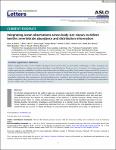Integrating ocean observations across body‐size classes to deliver benthic invertebrate abundance and distribution information
| dc.contributor.author | Ruhl, HA | |
| dc.contributor.author | Bett, BJ | |
| dc.contributor.author | Ingels, J | |
| dc.contributor.author | Martin, A | |
| dc.contributor.author | Gates, AR | |
| dc.contributor.author | Yool, A | |
| dc.contributor.author | Benoist, NMA | |
| dc.contributor.author | Appeltans, W | |
| dc.contributor.author | Howell, KL | |
| dc.contributor.author | Danovaro, R | |
| dc.date.accessioned | 2023-08-21T08:35:34Z | |
| dc.date.available | 2023-08-21T08:35:34Z | |
| dc.date.issued | 2023-05-31 | |
| dc.identifier.issn | 2378-2242 | |
| dc.identifier.issn | 2378-2242 | |
| dc.identifier.uri | https://pearl.plymouth.ac.uk/handle/10026.1/21249 | |
| dc.description.abstract |
Invertebrate animals living at the seafloor make up a prominent component of life globally, spanning 10 orders of magnitude in body size over 71% of Earth's surface. However, integrating information across sizes and sampling methodologies has limited our understanding of the influence of natural variation, climate change and human activity. Here, we outline maturing practices that can underpin both the feasibility and impact of establishing Benthic Invertebrate Abundance and Distribution as a Global Ocean Observing System—Essential Ocean Variable, including: (1) quantifying individual body size, (2) identifying the well‐quantified portions of sampled body‐size spectra, (3) taking advantage of (semi‐)automated information processing, (4) application of metadata standards such as Darwin Core, and (5) making data available through internationally recognized access points. These practices enable broader‐scale analysis supporting research and sustainable development, such as assessments of indicator taxa, biodiversity, biomass, and the modeling of carbon stocks and flows that are contiguous over time and space. | |
| dc.format.extent | 692-706 | |
| dc.language | en | |
| dc.publisher | Wiley | |
| dc.subject | 37 Earth Sciences | |
| dc.subject | 3708 Oceanography | |
| dc.title | Integrating ocean observations across body‐size classes to deliver benthic invertebrate abundance and distribution information | |
| dc.type | journal-article | |
| dc.type | Review | |
| plymouth.author-url | https://www.webofscience.com/api/gateway?GWVersion=2&SrcApp=PARTNER_APP&SrcAuth=LinksAMR&KeyUT=WOS:000998903400001&DestLinkType=FullRecord&DestApp=ALL_WOS&UsrCustomerID=11bb513d99f797142bcfeffcc58ea008 | |
| plymouth.issue | 5 | |
| plymouth.volume | 8 | |
| plymouth.publisher-url | https://aslopubs.onlinelibrary.wiley.com/doi/10.1002/lol2.10332 | |
| plymouth.publication-status | Published | |
| plymouth.journal | Limnology and Oceanography Letters | |
| dc.identifier.doi | 10.1002/lol2.10332 | |
| plymouth.organisational-group | |Plymouth | |
| plymouth.organisational-group | |Plymouth|Research Groups | |
| plymouth.organisational-group | |Plymouth|Faculty of Science and Engineering | |
| plymouth.organisational-group | |Plymouth|Faculty of Science and Engineering|School of Biological and Marine Sciences | |
| plymouth.organisational-group | |Plymouth|Research Groups|Marine Institute | |
| plymouth.organisational-group | |Plymouth|REF 2021 Researchers by UoA | |
| plymouth.organisational-group | |Plymouth|Users by role | |
| plymouth.organisational-group | |Plymouth|Users by role|Academics | |
| plymouth.organisational-group | |Plymouth|REF 2021 Researchers by UoA|UoA07 Earth Systems and Environmental Sciences | |
| plymouth.organisational-group | |Plymouth|Users by role|Researchers in ResearchFish submission | |
| dcterms.dateAccepted | 2023-05-03 | |
| dc.date.updated | 2023-08-21T08:35:22Z | |
| dc.rights.embargodate | 2023-8-23 | |
| dc.identifier.eissn | 2378-2242 | |
| rioxxterms.versionofrecord | 10.1002/lol2.10332 |


